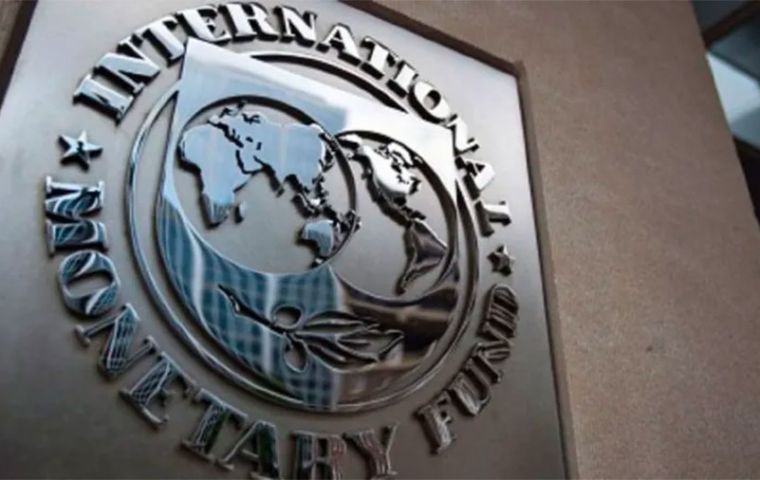MercoPress. South Atlantic News Agency
Gloomy IMF projections for Argentina this year
 Excluding Argentina and Venezuela, the IMF foresees a downward trend in inflation in the region
Excluding Argentina and Venezuela, the IMF foresees a downward trend in inflation in the region The International Monetary Fund (IMF) foresees a 2.5% drop in Argentina's GDP and warned that the program between the South American country and the credit agency was in a “critical” state, barely over one week ahead of the presidential elections.
After a vigorous post-pandemic recovery and resilience earlier this year, economic growth in Latin America and the Caribbean is projected to moderate from 4.1% in 2022 to 2.3% in 2023. Excluding Argentina and Venezuela, the organization also foresees a downward trend in inflation in the region, where it is projected to stand at 5% on average in 2023, down from 7.8% in 2022.
The IMF's Economic Outlook for the Americas released Friday in Marrakech, Morocco, also states that the retraction in Argentina's economic activity was due to the “severe drought” but a 2.8% expansion was projected for 2024.
The IMF projects that inflation in Argentina will reach 137.5% by the end of the year, although it “will depend on the evolution of the exchange rate pass-through and the degree of policy tightening”.
The report also warns that “downside risks continue to dominate the outlook, reflecting the fragile economic and social situation, election-related uncertainties, and vulnerability to external shocks”.
Hence, the IMF finds that “strong implementation and ownership of the IMF-supported program will be critical to safeguard stability and address persistent macroeconomic imbalances”. All in all, inflation would be reduced to 69.5% by the end of 2024.
Regarding public accounts, government primary spending is projected to fall from 39.6% of GDP in 2020 to 35.4% this year and 35.1% next year amid a reduction of the primary deficit from 1.8% of GDP in 2022 to 1.6% this year and 0.5% next year. It also contemplates a reduction in the government's gross debt from 89.5% of GDP in 2023 to 79.9% in 2024.
The report also points out that the vast reserves of critical minerals for the energy transition available in the region represent an opportunity to boost trade and production. Growing global demand for these minerals is expected to benefit South American countries with large reserves, including Chile, Peru, Brazil, Mexico, and Argentina.
“Latin America has successfully weathered recent global shocks and had a solid performance in 2022 and early 2023, although growth is weakening” argued Rodrigo Valdes, Director of the IMF's Western Hemisphere Department.
He explained that “The slowdown is the result of tighter policies adopted to contain inflation and the deterioration of the external environment, reflected among other things in slower growth in trading partners, less favorable external financing conditions, and lower commodity prices”.
External threats include slower growth in major trading partners, commodity price volatility, renewed inflationary shocks, a return of turbulence in global financial markets, and an intensification of geopolitical tensions. At a regional level, the main risks relate to a possible resurgence of inflationary pressures and heightened social tensions.
The Fund also believes that climate-related shocks pose significant challenges in the short and medium term, especially for Central America, Panama, and the Dominican Republic, and for the Caribbean as the region needs to brace for El Niño, a climatic phenomenon that could negatively affect economic activity, generating floods in Ecuador and northern Peru, and droughts in Colombia, Central America, and southern Peru. “Fortunately, countries such as Argentina, Paraguay, and Uruguay could benefit from a much-needed increase in rainfall”.
Medium-term growth prospects for Latin America remain “moderate”. Globally, emerging and developing economies are projected to grow by 4.4% on average, while the region's GDP is expected to expand annually by about 2.5%, in line with its historical average before the pandemic.
The Fund notes that “promoting sustainable and inclusive growth requires addressing long-standing structural problems, adapting to new challenges, and strengthening social cohesion”.




Top Comments
Disclaimer & comment rules-

Read all commentsWith sincere respect, Argentina has lost their ability to manage their economy.
Oct 15th, 2023 - 03:15 pm +1Dollarization is today the best solution!
From the current news: The U.S. dollar has outperformed all the 11 BRICS currencies in the last 3 months in the forex markets. BRICS is looking to dethrone the U.S. dollar as the world’s reserve currency by putting their local currencies forward for trade. Despite initiating multiple efforts to take on the U.S. dollar, BRICS currencies are ending at a low against the USD. The U.S. dollar not only outperformed BRICS currencies, but also surpassed gold, oil, and other commodities in the international markets”
* * *
Personally I'm staying with Madame while she recovers from her remarkable treatment in the USA.
¡Saludos de La Dehesa!
Commenting for this story is now closed.
If you have a Facebook account, become a fan and comment on our Facebook Page!